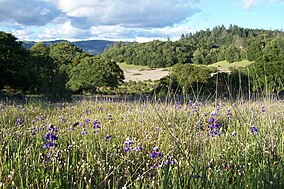Annadel State Park
| Trione-Annadel State Park | |
|---|---|
|
IUCN category II (national park)
|
|

Lupines in a meadow, Annadel State Park
|
|
| Location | Sonoma County, California, United States |
| Nearest city | Kenwood, California; Santa Rosa, California |
| Coordinates | 38°25′45″N 122°37′30″W / 38.42917°N 122.62500°WCoordinates: 38°25′45″N 122°37′30″W / 38.42917°N 122.62500°W |
| Area | 5,092 acres (2,061 ha) |
| Established | 1971 |
| Governing body | California Department of Parks and Recreation |
Trione-Annadel State Park is a state park of California in the United States. It is situated at the northern edge of Sonoma Valley and is adjacent to Spring Lake Regional Park in Santa Rosa. It offers many recreational activities within its 5,092-acre (2,061 ha) property.
The rock formations of Trione-Annadel have played central role in its history: its volcanic origins, the Native American use of obsidian, the early 1900s mining of cobblestones, and modern hikers' appreciation of its volcanic rock outcrops.
These lands were occupied by the Wappo and Pomo people in prehistoric times, who would have primarily inhabited the riparian zones and the marsh perimeter. Annadel includes what some biologists consider the best example of undisturbed northern oak woodlands in existence. Visitors can enjoy the park's diverse wildlife and scenery during any time of the year but are perhaps most rewarded from April through June when most wildflowers are in bloom.
Plant communities include California oak woodland, riparian woodland, Douglas fir forest, chaparral, grassland, and marsh. The dominant plant community is the oak woodland, which has a canopy of coast live oak, Garry oak, black oak, Pacific madrone, bigleaf maple, and California laurel. Canyon live oak occurs in swales and creeks. In the oak woodlands, the dominant understory plants are native bunchgrasses, toyon, wild blackberry, coyote brush, and western poison-oak. The latter covers nearly one quarter of the understory in the park. Douglas fir occurs in some of the steeper, cooler riparian zones and on north-facing slopes.
...
Wikipedia


